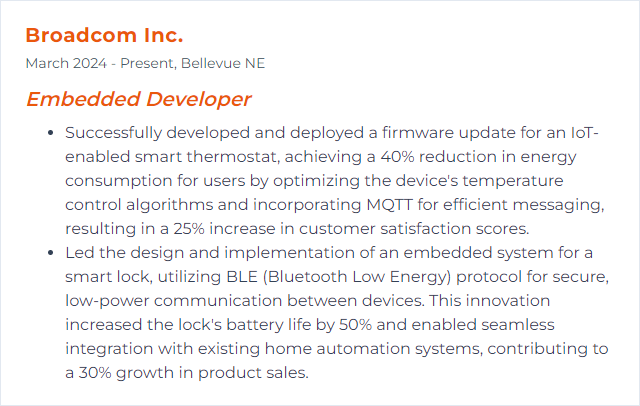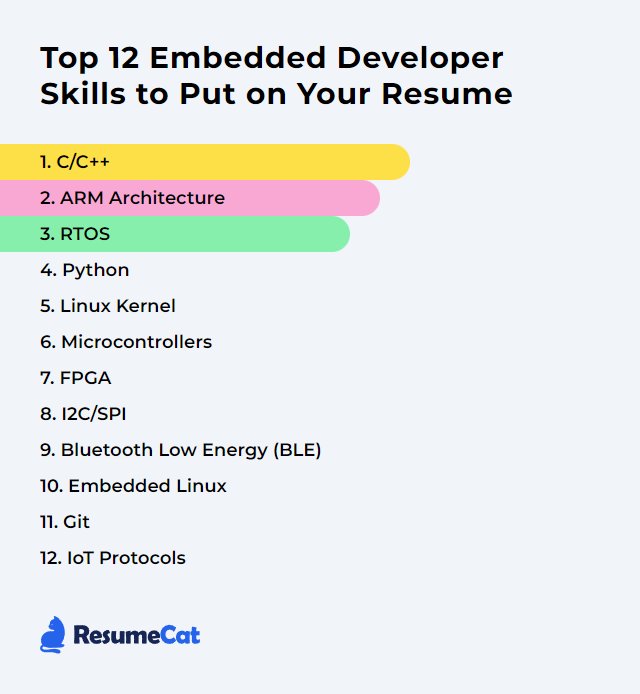Top 12 Embedded Developer Skills to Put on Your Resume
In today's fast-shifting tech landscape, embedded developers win by stacking the right skills, not just collecting buzzwords. What follows spotlights 12 core competencies worth putting on a resume, the kind that catch a hiring manager’s eye and map cleanly to real hardware, real constraints, real results.
Embedded Developer Skills
- C/C++
- ARM Architecture
- RTOS
- Python
- Linux Kernel
- Microcontrollers
- FPGA
- I2C/SPI
- Bluetooth Low Energy (BLE)
- Embedded Linux
- Git
- IoT Protocols
1. C/C++
C and C++ sit at the heart of firmware and low-level software, where bits meet pins. You get tight control over memory, timing, and hardware registers. No fluff, just power and precision.
Why It's Important
On constrained devices, every cycle and byte matters. C/C++ gives direct access to hardware and predictable performance, which translates to stable products and fewer late-night debugging marathons.
How to Improve C/C++ Skills
Master fundamentals: Pointers, memory layout, volatile, concurrency primitives, data structures, and algorithms. Know why undefined behavior bites.
Embedded mindset: Interrupts, memory-mapped I/O, DMA, caches, linkers, startup code, bootloaders. Read datasheets; wire code to silicon.
Build projects: Sensor drivers, buses (SPI, I2C, UART), low-power modes, debouncing, watchdogs. Ship small binaries; measure power.
Follow standards: Apply MISRA C and robust coding conventions. Favor clarity over cleverness; portability over shortcuts.
Optimize deliberately: Profile first. Reduce allocations, avoid fragmentation, trim recursion, leverage compile-time configuration, and use -O flags sensibly.
Work with an RTOS: Queues, mutexes, ISR vs thread context, priority inversion, timing analysis. Make tasks predictable.
Tooling and debugging: Cross-compilers, GDB, JTAG/SWD, logic analyzers, oscilloscopes. Read map files; track stack usage.
Keep learning: Dive into topics like edge ML, secure boot, and over-the-air updates. The field never sleeps.
How to Display C/C++ Skills on Your Resume

2. ARM Architecture
ARM is a family of RISC architectures built for efficiency. Everywhere in embedded: Cortex-M for microcontrollers, Cortex-A for rich OS, Cortex-R for real-time heavy lifters.
Why It's Important
Performance per watt. That’s the pitch and the payoff. ARM’s design keeps batteries alive and thermals tame without sacrificing throughput.
How to Improve ARM Architecture Skills
Know the core: Thumb/Thumb-2, exceptions, memory barriers, caches, MPU/MMU, vector tables. Read the TRM for your exact core.
Use the toolchain well: GCC or Clang with link-time optimization, link scripts, startup files, and map analysis. Understand what the optimizer does to your code.
NEON and DSP where it fits: SIMD can turn sluggish loops into streaming pipelines for audio, vision, and signal work.
Power management: Sleep states, clock gating, dynamic frequency scaling, wake sources. Measure, don’t guess.
RT work: For determinism, use Cortex-R or a carefully configured Cortex-M with an RTOS, tuned ISRs, and bounded latencies.
Debug and profile: Arm Development Studio, Keil MDK, vendor IDEs, ETM/ITM, trace, and performance counters. Hunt hotspots scientifically.
Stay current: New cores, security features like TrustZone-M, and revised errata come fast. Track them.
How to Display ARM Architecture Skills on Your Resume

3. RTOS
A Real-Time Operating System schedules tasks with deadlines that can’t be missed. Deterministic behavior, lean overhead, just enough abstraction to keep complexity in a cage.
Why It's Important
When timing is non‑negotiable, an RTOS gives structured concurrency, resource ownership, and predictable latency. Products stop jittering and start behaving.
How to Improve RTOS Skills
Priorities and scheduling: Assign priorities intentionally; avoid priority inversion; use ceiling protocols; keep ISRs short.
Memory discipline: Static allocation where possible, bounded queues, measured stacks, guarded heaps. No leaks, no fragmentation.
Latency shaving: Optimize ISRs, reduce tick rate if suitable, adopt tickless idle, and profile context switches.
Power-aware design: Idle hooks, sleep transitions, and timer coalescing. Pair with hardware sleep states.
Tracing and observability: Use runtime tracing to visualize tasks, locks, and CPU load. Catch deadlocks before they catch you.
Configuration tuning: Trim features, right-size stacks, calibrate timers. Minimalism buys headroom.
Security: Secure boot, MPU regions, least-privilege tasks, encrypted comms. Safety and security go hand in hand.
How to Display RTOS Skills on Your Resume
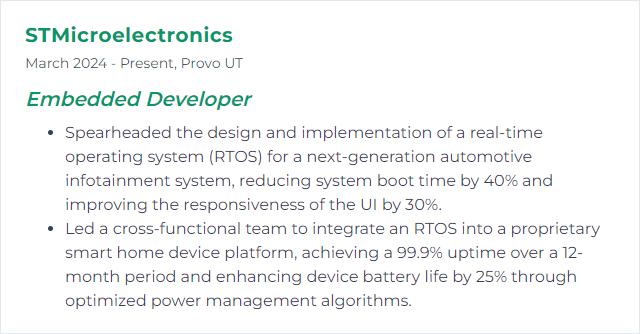
4. Python
High-level, expressive, and everywhere. In embedded, Python shines for scripting, testing, build tooling, data handling, and prototyping with boards that can run it.
Why It's Important
Faster feedback loops. Automated tests. Snappy tooling. Python lets you glue systems together and move ideas into hardware with less friction.
How to Improve Python Skills
Think embedded: Explore MicroPython or CircuitPython for microcontrollers, and use PySerial, socket programming, and GPIO libraries for host-side control.
Write efficient code: Profile, vectorize with NumPy when applicable, reduce allocations in tight loops, and cache what repeats.
Hardware in the loop: Run tests against real boards. Automate flashing, logging, and sanity checks. Make failure loud.
Modern libraries: Prefer gpiozero on Raspberry Pi over legacy RPi.GPIO. Use asyncio when concurrency fits.
Packaging and reproducibility: Virtual environments, pinned dependencies, and simple CLI tools for your team.
How to Display Python Skills on Your Resume
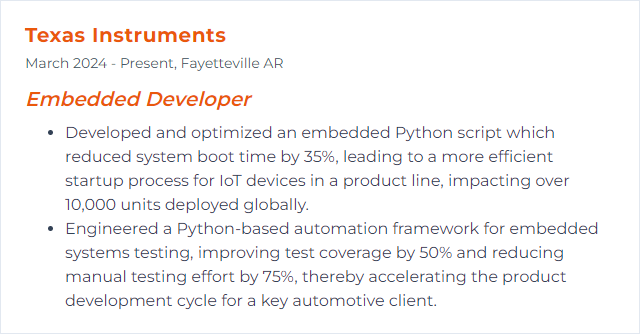
5. Linux Kernel
The kernel is the machinery under Embedded Linux: scheduling, memory management, drivers, filesystems, power, and IPC. Configure it right and it hums; get it wrong and it grinds.
Why It's Important
For complex devices, Linux provides a flexible, portable foundation with first-class driver support and networking. You tailor it; it scales with you.
How to Improve Linux Kernel Skills
Learn the internals: Processes vs threads, preemption, locking, workqueues, interrupts, device trees, memory zones, cgroups.
Build for your board: Cross-compile, prune configs, tune preemption model, and cut size with careful feature selection.
Device drivers: Write simple platform drivers, understand devicetree bindings, and manage power states correctly.
Profile and trace: perf, ftrace, eBPF (where supported), and lockdep. Data first, hunches second.
Harden and test: KASAN, KCSAN, KMSAN, Kernel Self Protection concepts, fuzzing, and static analysis. Keep security in the loop.
Contribute: Follow submission guidelines, read reviews, and iterate. The learning curve is steep and worth it.
How to Display Linux Kernel Skills on Your Resume
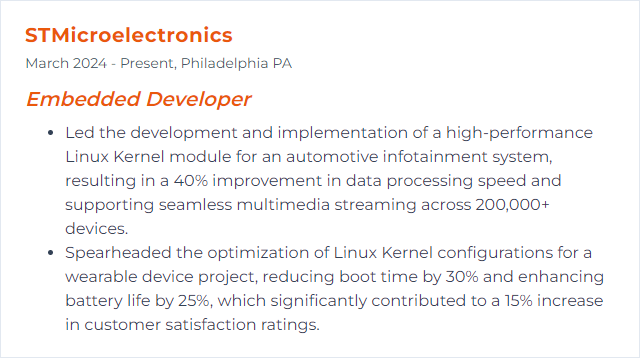
6. Microcontrollers
Self-contained chips with CPU, memory, and peripherals. They run the world’s quiet work: sensing, control, safety loops, the ticking heart of products.
Why It's Important
MCUs bring deterministic control at low cost and power. From toys to turbines, they enable fast, reliable, single-purpose computation.
How to Improve Microcontrollers Skills
Power first: Use sleep modes, clock scaling, and peripheral gating. Plan wake sources; measure current over full duty cycles.
Firmware efficiency: Use fixed-point where possible, enable compiler optimizations, reduce copies, and prefer static allocation.
RTOS when it helps: If concurrency is real, adopt an RTOS and structure tasks cleanly. If not, keep it superloop-simple.
Serious debugging: JTAG/SWD, data trace, ITM printouts, and logic analyzers. Capture, don’t guess.
Extend smartly: Add external modules (sensors, radios, coprocessors) instead of jumping to a larger MCU when it’s not needed.
Robust comms: Tune CAN, UART, I2C, SPI. Handle errors, timeouts, and retries. CRCs aren’t optional.
Standards and safety: Follow MISRA C, apply defensive coding, and design for fail-safes and watchdog recovery.
Never stop learning: New MCU families and toolchains arrive constantly. Evaluate, prototype, compare.
How to Display Microcontrollers Skills on Your Resume
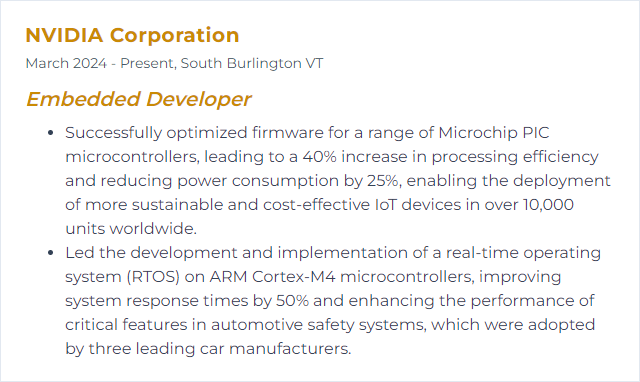
7. FPGA
Reconfigurable logic you can shape into custom accelerators, pipelines, and interfaces. Hardware that behaves like software, but blazingly parallel.
Why It's Important
When CPUs choke on latency or throughput, FPGAs step in. Real-time signal processing, motor control, vision—tailor-made speedups.
How to Improve FPGA Skills
Write clean HDL: Synchronous design, reset strategy, no latches, resource-aware state machines. Simpler code, better timing.
Clocking discipline: Clock enables, domain crossing with proper synchronizers, and timing constraints that match reality.
Resource balance: Keep an eye on LUTs, BRAMs, DSP slices. Nudge the synthesizer with pragmas only when justified.
Pipeline and parallelize: Break long combinational paths; stream data; make throughput king and latency predictable.
Power matters: Reduce switching, gate clocks, shrink toggling nets. Heat sinks are not a strategy.
Use IP wisely: Leverage vendor IP for common blocks and focus effort where you differentiate.
Simulate, then verify on hardware: Unit tests in simulation, timing closure in tools, and on-board checks with ILA/SignalTap.
How to Display FPGA Skills on Your Resume

8. I2C/SPI
I2C and SPI are the bread-and-butter buses that glue sensors, memories, and displays to your MCU or SoC.
I2C: two wires, open-drain, multi-master capable, great for short distances and moderate speeds with many devices.
SPI: four wires minimum, full duplex, simple and fast, ideal for high-throughput peripherals and deterministic timing.
Why It's Important
These protocols keep BOMs tidy and interconnects sane. Fewer pins, faster integration, predictable transfers.
How to Improve I2C/SPI Skills
I2C Improvement Strategies
Right clock rate: Stay within device limits and signal integrity margins. Fast Mode and Fast Mode Plus only when your layout supports it.
Pull-ups tuned: Size pull-up resistors based on bus capacitance and speed. Too strong wastes power, too weak kills edges.
Clock stretching caution: Allow it if required, but minimize; it drags throughput and complicates timing.
SPI Improvement Strategies
Push the clock sensibly: Max out within device specs and board limits. Verify with a scope, not just a datasheet.
Layout discipline: Short traces, clean returns, matched lengths for high speeds, and solid grounding. Keep noise away from SCK.
Use DMA: Offload transfers to DMA for low CPU overhead and consistent timing.
Match modes: CPOL/CPHA and bit order must align across devices. One mismatch and it’s ghost-bug city.
General Tips
Instrument everything: Logic analyzers and scopes reveal timing, glitches, and contention.
Defensive firmware: Timeouts, retries, CRCs, and bus reset sequences. Assume noise happens.
Interrupt-friendly drivers: Keep ISRs swift, use ring buffers, and batch transfers when possible.
How to Display I2C/SPI Skills on Your Resume

9. Bluetooth Low Energy (BLE)
Low-power wireless for short hops. Sensors, wearables, tags, remotes—BLE keeps batteries alive and data flowing.
Why It's Important
BLE enables cable-free products that run for months or years. Interoperable, ubiquitous, and tuned for tiny energy budgets.
How to Improve Bluetooth Low Energy (BLE) Skills
Power strategy: Tune connection intervals, supervision timeouts, and advertising cadence. Use deep sleep and wake only when needed.
Throughput and latency: Pick PHY (1M, 2M, or Coded), adjust data length and connection parameters, and minimize unnecessary acknowledgments.
Robust links: Adaptive frequency hopping, channel maps, retry strategies, and graceful reconnection flows.
Security: Use secure pairing, bonding, and strong keys. Protect GATT characteristics with access controls.
BLE 5.x features: Leverage extended advertising, long-range (Coded PHY), periodic advertising, and LE Audio where supported.
Measure and profile: Power profilers and air sniffers expose hidden drains and protocol missteps.
How to Display Bluetooth Low Energy (BLE) Skills on Your Resume
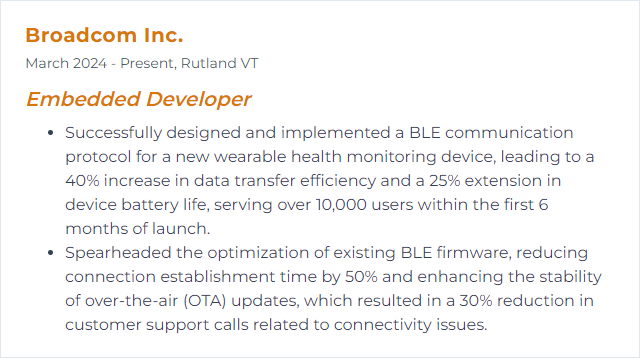
10. Embedded Linux
A tailored Linux stack for devices. Kernel, rootfs, bootloader, middleware—composed to fit your hardware and constraints.
Why It's Important
You get a modern networking stack, drivers galore, and a well-understood development flow. Customizable from tiny headless nodes to rich HMI systems.
How to Improve Embedded Linux Skills
Kernel and userspace trimming: Strip unneeded drivers and features. Choose the right preemption model, and configure for your SoC.
Reduce boot time: Profile with systemd-analyze, pare services, use parallelization, and consider initramfs tweaks. Buildroot or Yocto/OpenEmbedded for finely curated images.
Memory and storage: Use lightweight libs, mmap where it helps, compress wisely, and pick filesystems that suit your read/write patterns (e.g., SquashFS for read-only).
Security hardening: Secure boot, verified updates, partitioning of privileges, and sandboxing. Keep SBOMs and patch aggressively.
Power management: DVFS, suspend/resume, runtime PM. Confirm gains with tools like PowerTOP and real measurements.
Real-time needs: PREEMPT_RT, fine-grained IRQ affinity, and isolated CPUs if latency is king.
CI/CD for firmware: Automated builds, tests (including hardware-in-the-loop), and reproducible images. OTA with A/B updates or content-addressed storage like OSTree.
How to Display Embedded Linux Skills on Your Resume
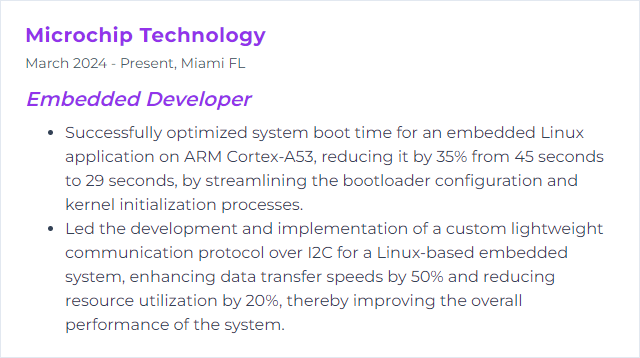
11. Git
Distributed version control that keeps teams sane. Track changes, branch with confidence, bisect bugs, and ship cleanly.
Why It's Important
Firmware evolves with hardware. Git records history, enables safe experimentation, and supports disciplined releases—vital when devices live in the field for years.
How to Improve Git Skills
Core fluency: Rebase, cherry-pick, bisect, stash, and worktrees. Understand what the index is doing.
Branching model: Adopt a clear workflow (trunk-based or Git Flow) and enforce it with reviews and CI checks.
Git hooks and automation: Lint, format, and run unit tests before code lands. Small guardrails, big gains.
CI integration: Automatic builds, tests, static analysis, and artifact storage for firmware and companion tools.
Handle large binaries: Use Git LFS for images and build outputs to keep repositories lean.
Keep history readable: Squash noise, write clear messages, and prune stale branches. Your future self will thank you.
How to Display Git Skills on Your Resume
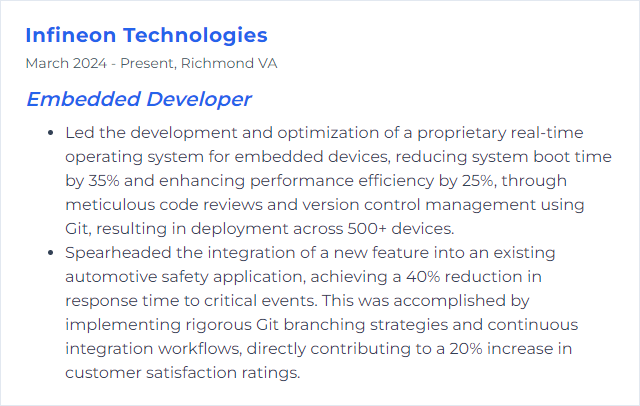
12. IoT Protocols
Standards and stacks that let devices talk—reliably, securely, and at scale. Think MQTT, MQTT-SN, CoAP, LwM2M, Zigbee, Thread, Matter, and also transport layers like BLE, Wi‑Fi, and cellular.
Why It's Important
Interoperability keeps ecosystems from fragmenting. Protocol choices ripple through power budgets, reliability, and backend design.
How to Improve IoT Protocols Skills
Security first: Strong crypto, mutual auth, secure provisioning, and key rotation. Protect data at rest and in transit.
Efficiency: Keep payloads small, compress when sensible, reduce chatter with event-driven updates, and exploit QoS levels well.
Interoperability: Follow specs strictly, validate with conformance tools, and map data models consistently (e.g., LwM2M object models).
Scalability: Architect with brokers and gateways, backpressure, and rate limits. Plan for NAT traversal and IPv6 where appropriate.
Resilience: Exponential backoff, offline buffering, idempotent operations, and careful session handling.
How to Display IoT Protocols Skills on Your Resume
